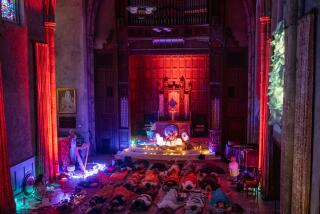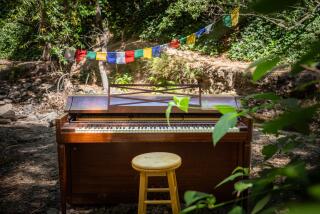Churches Suffer Notable Shortage of Organists
- Share via
PITTSBURGH — In the beginning, just about every church in America had an organ and an organist, making music that filled the sanctuaries, stirred the soul and uplifted the spirit.
“Rock of Ages.” “How Great Thou Art.” Leading the human voice in song was the power and substance of an organ.
Not so now.
“I tell preachers, ‘If you’ve got a good organist, chain him to the bench,’ ” said pipe organ builder and restorer Harry J. Ebert of Pittsburgh.
No one knows for sure how many of the country’s 255,000 churches, cathedrals and synagogues have organs, but a good guess is that at least half--if not most--have some kind of an organ, said Barbara Mansfield of the American Guild of Organists in New York.
The trouble is finding someone to play it.
Some churches are so desperate for an organist that they will recruit a pianist to play the organ, Mansfield said.
But pianists also are getting hard to come by, and, more significantly, the two instruments just aren’t the same. A piano requires only two hands. An organ requires two hands, two feet and a knowledge of all those buttons and knobs that change the tone and texture of a piece of music.
“And you may be directing a choir with one hand in the air,” adds Ann Labounsky, head of the organ department at Duquesne University in Pittsburgh. “You simply cannot learn the organ in 10 easy lessons. It takes a tremendous amount of coordination.”
Labounsky has seen her department shrink steadily over the past three decades, but it still ranks as one of the largest in the country even with only 25 undergraduate and graduate students.
Nationwide, about 600 university students are enrolled in organ programs, according to the National Assn. of Schools of Music in Reston, Va. Some, like Duquesne, even discount tuition by half if a student plays in a church.
Concurrently, organ sales have plummeted from a peak of 222,000 in 1977 to an all-time low of 17,500 in 1995, according to the National Assn. of Music Merchants.
What that translates into is a real change in the way people worship.
In Bucyrus, Kan., the only church in town has an organ but no organist. There’s a piano but not always someone to play it.
“So we sing without it. We improvise,” said the Rev. Larry Buss, minister of the United Methodist Church of Bucyrus.
In Gibsonia, Pa., Deer Creek United Presbyterian Church has been looking for an organist for several months and hasn’t had a nibble, said the Rev. Byron McElroy.
“Organists just seem to be in short supply,” he said. “And trained organists are looking for a full-time position, which we can’t afford.”
To fill the musical gap, Deer Creek Church occasionally has hired bagpipers, singers and a drama troupe for individual services.
In Dupont, Wash., the Rev. Paul Naumann uses computer-generated music to accompany worshipers at Ascension Lutheran Church. At key intervals in the service, Naumann presses a remote on-off switch that turns on “a big fancy boom box.”
It’s better, he said, than singing with no accompaniment.
“The thought of holding an a cappella service is a terrible one for many pastors. Many would try anything than resort to that,” he said.
But many churches have spent big money on their organs, which range from tens of thousands of dollars for a plain electronic model up to $2 million for a magnificent pipe organ. Churches simply are not willing to mothball such a huge investment.
And, perhaps more importantly, music draws church members.
“If we don’t get an organist or if they want $250 a week or something, we’ll have to start piping in music on a tape recorder. And that might ruin the church,” said Bob Petrick of Rosedale Methodist Church in Penn Hills, Pa.
Petrick’s church has an organist now, but as in many other churches, the musician is elderly and wants to quit.
“Bob wants to see me up there playing when I’m 80,” said organist Walt Hendershot, who’s now 70 and tendered his resignation at Rosedale starting in September.
Hendershot, a retired accountant, has been playing the organ in church since 1952. He makes about $115 a week, which includes up to five hours a week of choir rehearsal, three or four hours a week practicing the anthems and hymns and an hour for the actual service.
But the worst part of the job, Hendershot said, is that he has to find his own replacement when he wants a day off.
Even when churches are offering a full-time job with a salary of $30,000 and the chance to play a new $500,000 pipe organ--as in the case of Ingomar United Methodist Church in suburban Pittsburgh--applicants are hard to find.
“I thought that in a city the size of Pittsburgh, it would be no big deal to find an organist,” said Sally Johnson, chairwoman of the music committee at Ingomar Methodist. “We didn’t have one young person apply.”
Organist Gretchen Franz, 50, of suburban Pittsburgh, said she understands why young people aren’t interested in the organ.
First, churches don’t pay enough, she said. And, surprisingly, organists suffer a lot of burnout.
“I am always on call,” said Franz, who earns $30,000 a year as full-time organist and music director of Mount Lebanon Methodist Church. “I’ve never worked less than six days a week, and if there’s a funeral on the seventh day, well, you work that too.”
More to Read
Sign up for Essential California
The most important California stories and recommendations in your inbox every morning.
You may occasionally receive promotional content from the Los Angeles Times.










